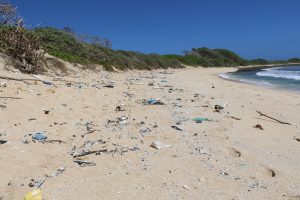Marine Debris Most Prevalent on Niʻihau
Of all the main Hawaiian Islands, Niʻihau has the most marine debris washing up on its shores, according to a new study released by the Department of Land and Natural Resources and the North Pacific Marine Science Organization.
The study found that 38% of the total debris identified in aerial surveys is located on the beaches of Niʻihau. The inundations is likely due to the island’s position in the island chain and the ocean currents surrounding it.
All other islands had 14% or less, with O‘ahu having the least density at 5%.
Video courtesy of Hawai‘i DLNR
The Hawai‘i Island imagery analysis identified 2,200 pieces of marine debris. Most common type was plastic (52%). Marine debris was concentrated on the southeastern tip of the island, particularly around Kamilo Point.
“This could be a reflection of continuous beach clean-ups conducted by local residents and conservation organizations,” state Department of Land & Natural Resources officials said.
“It’s heartbreaking to see a marine mammal tangled up in derelict fishing line,” DLNR officials said. “It’s sad to see an otherwise beautiful Hawaiian beach covered in a vast array of plastic. It’s telling when the stomach contents of seabirds often show they’ve ingested these plastics. Marine debris can have numerous impacts on the natural environment, many of them detrimental to the overall health of the ecosystem.
A DLNR and North Pacific Marine Science Organization-commissioned aerial survey of the coastlines of the main eight Hawaiian Islands has revealed that plastic items constitute most of the marine debris landing on our shores.
The study, “Japanese Tsunami Marine Debris Aerial Imagery Analysis and GIS Support in the Main Hawaiian Islands,” was funded by the Ministry of the Environment of Japan as part of the Japan Tsunami Gift Fund awarded to western states, including Hawai’i.
“In order to characterize the potential ecological consequences of tsunami and other debris, it’s important to quantify it,” said DLNR Division of Aquatic Resources Marine Debris Coordinator Kirsten Moy. “Understanding the types, sizes and locations of debris accumulating on Hawaiian coastlines is crucial in developing plans to streamline removal and mitigate negative impacts.”
“This survey found a very limited amount of debris associated with the Japan tsunami,” said DLNR Chair Suzanne Case.
“Most of what was mapped are common, everyday items that someone haphazardly tossed onto the ground or directly into the water,” Case said. “These items get caught up in ocean currents and unfortunately much of it eventually lands, mostly on north and east-facing shores.
“Hawai’i is recognized around the world for our beautiful beaches. Unfortunately we cannot say they are pristine, because they’ve been so seriously impacted by our trash,” Case said.
Survey Synopsis for Each Island
Hawai‘i Island Imagery analysis identified a total of 2,200 pieces of marine debris. Most common type was plastic (52%). Marine debris was concentrated on the southeastern tip of the island, particularly around Kamilo Point.
Maui Imagery analysis identified a total of 1,749 pieces of marine debris. Most common type was plastic (40%). Marine debris was concentrated on the northern side of the island, particularly around Kahului.
Kaho‘olawe Imagery analysis identified a total of 1,298 pieces of marine debris. Most common type was plastic (47%). Marine debris was concentrated on the northern tip of the island and in the Keoneuli area on the eastern coast.
Lāna‘i Imagery analysis identified a total of 1,829 pieces of marine debris. Most common type was plastic (53%). Marine debris was concentrated on the northeast coast of the island.
Moloka‘i Imagery analysis identified a total of 2,878 pieces of marine debris. Most common types were plastic (37%) and buoys & floats (35%). Marine debris was concentrated on, north western shores and a small area on the northeastern corner of the island.
O‘ahu Imagery analysis identified a total of 984 pieces of marine debris. Most common type was plastic (63%). Marine debris was concentrated on the northern tip of the island, particularly around Kahuku.
Kaua‘i Imagery analysis identified a total of 1,849 pieces of marine debris. Most common type was plastic (49%). Marine debris was concentrated on the eastern shores of the island, particularly at the northern and southern extents.
Ni‘ihau Imagery analysis identified a total of 7,871 pieces of marine debris. Most common type was plastic (46%), followed by buoys and floats (25%). Ni‘ihau had the great debris densities on east-facing shores.
In addition to plastic, buoys and floats, the surveys identified derelict fishing gear, foam, tires and “other” types of debris, including wood, metal, cloth and vessels.
Download the full report.












